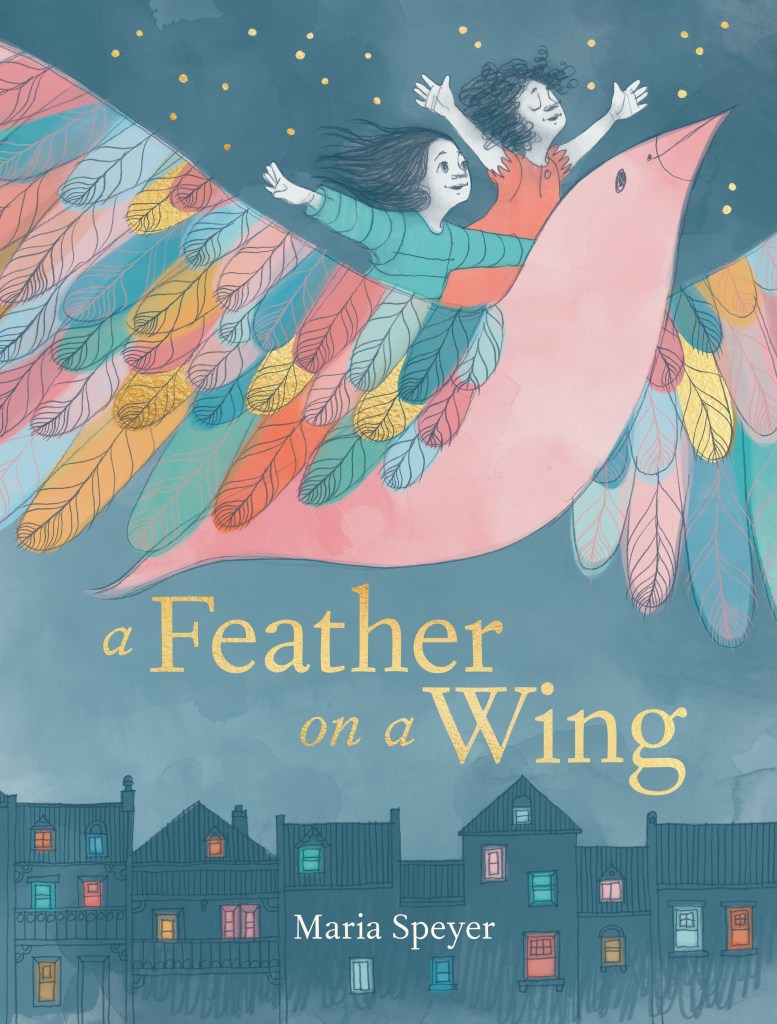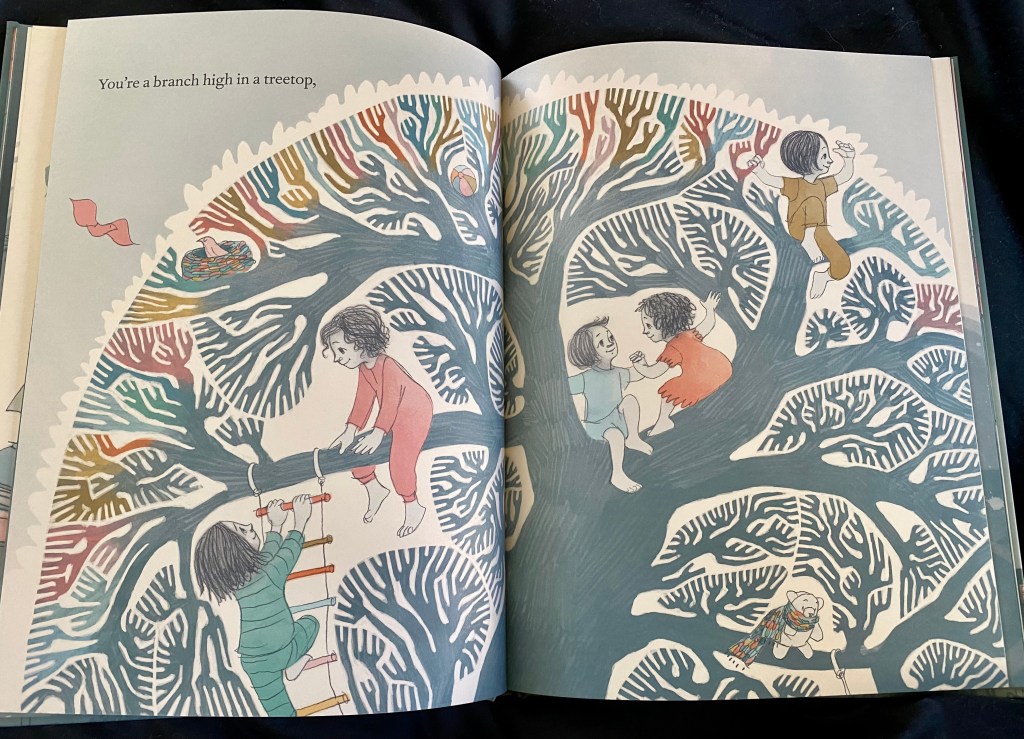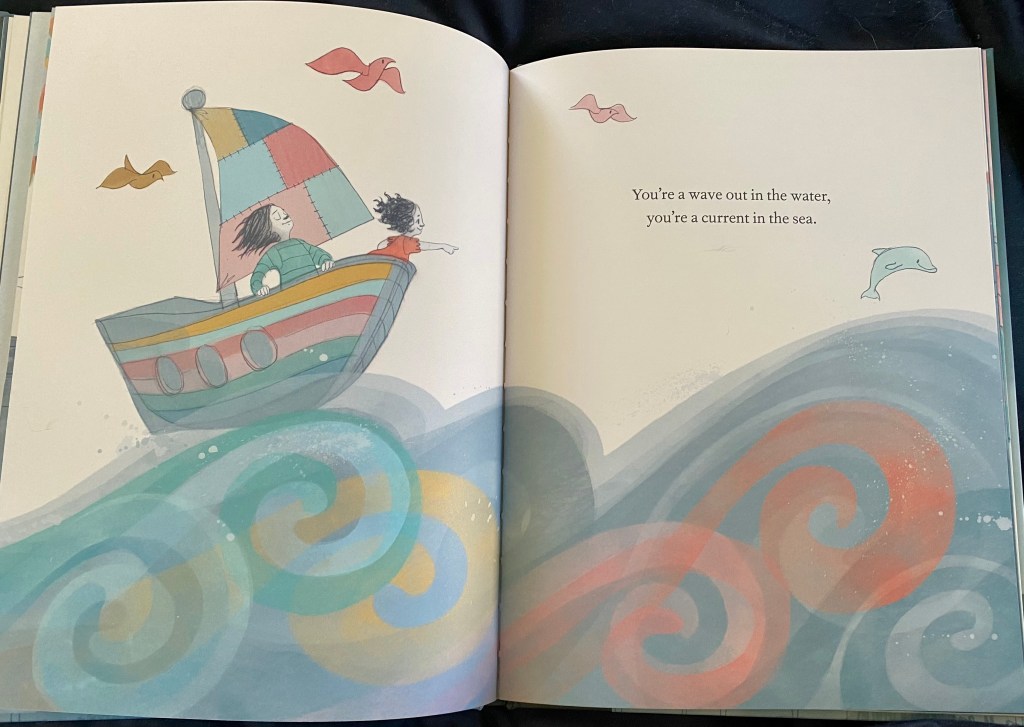A Feather on a Wing
by Maria Speyer

Danish artist, illustrator and author Maria Speyer’s debut picture book in English is A Feather on a Wing. It has an ethereal feel yet is grounded in a sister’s love, nurturing nature and access to a world constructed with care and warmth that is growing and inclusive.
A Feather on a Wing is published by University of Queensland Press.
Maria writes beautifully and with insight for PaperbarkWords about the genesis of this work, her process and her hope for her book:
So often we encourage kids to find strength within themselves and to be independent. Yet, all around us, the world is made up of small things that are part of something bigger – like a petal on a flower or a rung on a ladder. A Feather on a Wing began as a wish to encourage kids to imagine themselves the same way – as part of something more – because I think we often forget to reassure them that relying on others is not a weakness, and that being there for others is so very important.
As COVID changed our world and we all lived through lockdowns, separation, and the kind of darkness that isolation is, A Feather in a Wing evolved into a rhyme and a lullaby. After all, it is in the darkness and in the night that we feel most alone and are most in need of reassurance.

You Are Not Alone
In the story, a young girl calls into the darkness that she feels alone, and her older sister responds by taking her on a journey through metaphors for connection and belonging. The metaphors are like a string of separate tableaus – from flowers in a daisy chain to waves in the water. In the illustrations these are woven together to tell a parallel a story of inclusion. In the pictures, the two girls set out on a journey where they find comfort and colour in the darkness, and as we turn the pages, more and more kids join in this joyful, shared dream.

A Soothing Rhythm
The purpose of the book is to reassure, and this has guided both the choice of metaphors, the pace of the rhyme, the melody, palette, line, and texture.
For example, I’ve used metaphors that evoke very positive ways of belonging, and I’ve kept the rhyme steady and consistent. I wanted the reader to feel soothed and safe, which is also why the melody (notated on the back spread) has a circular, open ended form with no natural finishing chord. In other words, you can repeat the melody for as long as you like – or until you fall asleep!

One very important aspect of the book is colour. Spots of bright colour on every page help the reader pick out individuals in each community – individual branches on a tree, for example, or stitches in a scarf – giving each element a presence and a story of its own. The colours play out their stories with the night as backdrop, but this is a comforting darkness in a monochrome grey-blue with lots of layers, texture, and depth.
All the colours in the book are, in fact, applied digitally to hand-drawn, monochrome lines and textures. I used pencil for the lines and different kinds of graphite and ink for the hatches and washes, leaving everything a bit loose and sketchy. A lot of guidelines and scribbles a still visible in the illustrations to give a sense of tactility, and connection. This process of hand-drawing everything in a very immediate way (with lots of redrawing and reworking and piles of paper in every corner of my studio) and then controlling the colours digitally meant that drawings, words, and melody could develop in parallel, keeping the process open and changeable for as long as possible and making sure the elements moved to the same soothing rhythm.
To Make and To Include
Keeping the process open and everything clearly handmade are important to me whatever I make – and I make a lot of stuff (compulsively). I knit and crochet, I bake and build stuff. I also draw big charcoal drawings that go on people’s walls and write about the phenomenology of the drawing process. But all this incessant making comes from the same desire to connect to the world and to others. I don’t think of the things I make as presentations of my point of view or as statements. To me, making is an ongoing process of reaching into the world to feel part of it and to reach out to others.
When we look at something that is hand drawn or hold something handmade I think we connect with the maker – sometimes when we’re touching the same surface (when we’re holding a wheel-thrown mug), sometimes through the care the maker put into it (when we wear a hand knitted jumper like a warm hug), and sometimes because we’re in the same position as the maker (when we look at a canvas and can see the movements of the painter’s hand in the brushstrokes). Flaws don’t matter. What matters is that we feel included in the work.
A Warm Hug
A Feather on a Wing is about making kids feel included. It’s about how we imagine ourselves in the context of the world and how we encourage others to imagine themselves. It’s natural, of course, that we want our kids to be strong and independent, but I think it’s equally important to reassure them (and ourselves) that we don’t have to do everything alone.
Perhaps what I really want is for A Feather on a Wing to be like a handmade jumper, knitted with care in the hope that it’ll feel a bit like a warm hug.


This book is a pure joy; the images, words and music perfectly match the intention to reassure and comfort. I warmly recommend it for all mothers and fathers, sisters and brothers, and anyone who can still remember feeling singularly alone in the dark.
LikeLiked by 1 person
So true Tamara
LikeLike